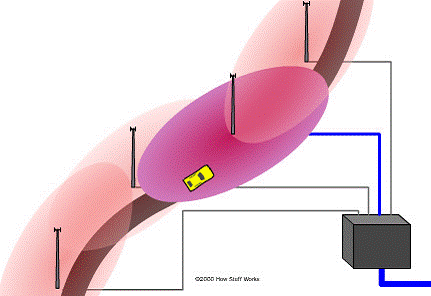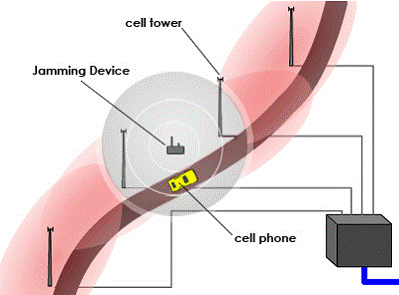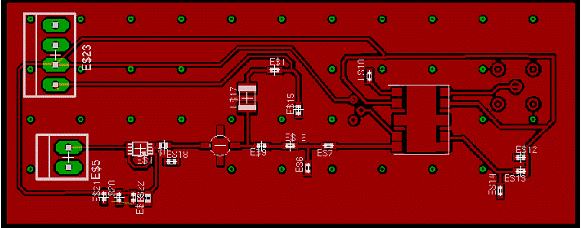A GSM jammer or cell phone jammer is a device that transmits signals on the same frequency on which the GSM system operates, and is successful when cell phones in the area where the jammer is located are disabled.
Communication jamming equipment was first developed and used by the military.
When tactical commanders use RF communications to control their forces, those communications are of interest to the enemy. This interest comes from the fundamental realm of denial of successful transmission of information from sender to receiver.
Today, mobile jammer devices or cell phone jammer software are becoming civilian products rather than electronic warfare devices because as the number of cell phone users increases, so does the need to disable cell phones in specific places where cell phone ringtones cause disturbance. These places Includes places of worship, university lecture halls, libraries, concert halls, conference rooms, and other places where silence is desired and Mobile jammer is a safety measure.
Introduction to mobile phone jammer
A jamming device neutralizes a cell phone by sending a signal on the same frequency as the cell phone and at a high enough power that the two signals collide and cancel each other out. Cell phones are designed to increase power when they encounter low-level interference, so the jammer must recognize and match the increased power of the cell phone. Cell phones are full-duplex devices, which means they use two separate frequencies, one for talking and one for listening at the same time. Some jammers only block one of the frequencies used by the phone, which has the effect of blocking both.
The phone is tricked into thinking there is no service because it can only receive one of the frequencies. Less sophisticated devices will only block one set of frequencies, while sophisticated jammers can block multiple types of networks at once to stop dual-mode or tri-mode phones from automatically switching between different network types in search of an open signal. Some high-end devices block all frequencies at once, while others tune to specific frequencies.
To jam a cell phone, all you need is a device that broadcasts on the correct frequency. All cell phone networks use radio signals that can be interrupted, although different cellular systems handle the signal differently. GSM is used for digital cellular and PCS-based systems, using the 900-MHz and 1800-MHz frequency bands in Europe and Asia, and the 1900-MHz (sometimes called 1.9-GHz) frequency band in the United States. The jammer can broadcast on any frequency and is effective against AMPS, CDMA, TDMA, GSM, PCS, DCS, iDEN and Nextel systems. Older analog cell phones are just as susceptible to interference as today’s digital devices. Jamming a cell phone is the same as jamming any other type of radio communication. Cell phones work by communicating with their service network through cell towers, or base stations. Cell phone towers divide cities into small areas, or subdivisions. Signals are passed from tower to tower as cell phone users drive down the street.


The jamming device transmits on the same radio frequency as the cell phone, disrupting communications between the cell phone and the cell towers in town
This is the so-called denial of service attack. Jammers deny radio spectrum service to cell phone users within range of the jamming device. older jammers were sometimes
Restricted to work on phones that use only analog or older digital mobile phone standards. Newer models such as dual and tri-band jammers can block all widely used systems (AMPS, iDEN, GSM, etc.), and are even very effective against newer phones that jump to different frequencies and systems when jammed. Because the main network technologies and frequencies used by mobile phones vary around the world, some are only available in certain regions such as Europe or North America.
The impact of a jammer can vary widely based on factors such as distance from the tower, indoor and outdoor settings, the presence of buildings and landscaping, and even temperature and humidity. There are concerns that poorly designed jammers could disrupt the function of medical devices such as pacemakers. However, like cell phones, most commonly used devices run at low enough power output (<1W) to avoid causing any problems
Circuit diagram of mobile phone jammer jpg
A jamming device neutralizes a cell phone by sending a signal on the same frequency as the cell phone and at a high enough power that the two signals collide and cancel each other out. Cell phones are designed to increase power when they encounter low-level interference, so the jammer must recognize and match the increased power of the cell phone. Cell phones are full-duplex devices, which means they use two separate frequencies, one for talking and one for listening at the same time. Some jammers only block one of the frequencies used by the phone, which has the effect of blocking both. The phone is tricked into thinking there is no service because it can only receive one of the frequencies. Less sophisticated devices will only block one set of frequencies, while sophisticated jammers can block multiple types of networks at once to stop dual-mode or tri-mode phones from automatically switching between different network types in search of an open signal. Some high-end devices block all frequencies at once, while others tune to specific frequencies.

To jam a cell phone, all you need is a device that broadcasts on the correct frequency. All cell phone networks use radio signals that can be interrupted, although different cellular systems handle the signal differently. GSM is used for digital cellular and PCS-based systems, using the 900-MHz and 1800-MHz frequency bands in Europe and Asia, and the 1900-MHz (sometimes called 1.9-GHz) frequency band in the United States. The jammer can broadcast on any frequency and is effective against AMPS, CDMA, TDMA, GSM, PCS, DCS, iDEN and Nextel systems. Older analog cell phones are just as susceptible to interference as today’s digital devices. Jamming a cell phone is the same as jamming any other type of radio communication. Cell phones work by communicating with their service network through cell towers, or base stations. Cell phone towers divide cities into small areas, or subdivisions. Signals are passed from tower to tower as cell phone users drive down the street
Type “A” Devices: Jammers:
In this device we overwhelm the cell phone signal with a stronger signal, this type of device is equipped with several independent oscillators that transmit “jamming signal” capable of blocking frequencies used by paging devices as well as cellular/PCS system control channels The frequency used for call setup. When activated in a designated area, these devices will prevent (through RF interference) all pagers and mobile phones located in that area from receiving and sending calls. This type of device only transmits interfering signals and is very poorly frequency selective, which results in interference with a larger communications spectrum than its intended target. Technologist Jim Mahan said: “There are two types. One is called brute force jamming, and it just blocks everything. The problem is, it’s like power washing the airwaves, and it infiltrates public address areas. The other is A small amount of signal interference is sent out, and you can confine it to a cell block. You can use many small small interferences to control the facility.
Type “B” Device: Smart Cell Disabler
Unlike jammers, Class “B” devices do not transmit jamming signals on the control channel. This device can be used as a “detector” when located in a designated “quiet” area. It has a unique identification number that communicates with the cellular base station. When a “B” type device detects a cell phone in a quiet room; the “filtering” (i.e. preventing call setup authorization) is done by the base station’s software.
When a base station sends a signaling transmission to a target user, the device, after detecting both the presence of that signal and the presence of the target user, signals to the base station that the target user is in a “quiet” room; therefore, do not establish communication. If the user subscribes to a voicemail service, the message may be routed to the user’s voicemail box. This process of detecting and interrupting call setup is done within the time intervals normally reserved for signaling and handshaking. For “emergency users”, the intelligent detection device makes provisions for designated users with emergency status. These users must pre-register their phone numbers with the service provider. When an incoming call arrives, the detector identifies the number and the call is established within a specified maximum duration, say two minutes. Emergency users can also make outside calls. Similarly, the system is able to recognize and allow all emergency calls routed to “911”.
It should be noted that the “B” type detector equipment is an integral part of the cellular/PCS system and needs to be provided by the cellular/PCS service provider, or provided by a third-party cooperation, fully supporting the cellular/PCS service provider.
Type “C” Devices: Smart Beacon Disablers
- Unlike jammers, Class “C” devices do not transmit jamming signals on the control channel. When located in a designated “quiet” area, the device acts as a “beacon” and any compatible terminal is instructed to disable its ringer or disable its operation within the coverage of the beacon. Only terminals with compatible receivers will respond, usually based on a different technology than cellular/PCS eg cordless wireless, paging, ISM, bluetooth. When leaving the beacon’s coverage area, the phone must re-enable its normal functions.
- The technology does not cause interference and does not require any changes to existing PCS/cellular operators. The do hidden camera detector jammer apps technology does require the smartphone to have a beacon system receiver separate from the cellular/PCS receiver. It will not prevent normal operation of incompatible legacy terminals in “quiet” coverage areas, so effective deployment will be problematic for many years.
- While generally uninformed users would lose functionality, pre-designated “emergency” users could be notified of a “bypass terminal key sequence” to disable responses to beacons. Assuming the technology used by the beaconing system has its own license (or is covered by a license exemption), deploying such a system would require no regulatory changes. With this system in place, it is very difficult to police the abuse of “bypass key sequences” by users.
Type “D” equipment: direct receive and transmit jammers
-
-
- This kind of jammer is like a small, independent, portable base station,
which can directly interact with the operation of the local mobile phone
intelligently or non-intelligently. The jammer is mainly in receive mode, if the
phone is close to the jammer, it will intelligently choose to interact and block
the phone directly.
- This kind of jammer is like a small, independent, portable base station,
-
-
-
- This selective jamming technique uses discriminative receivers to target
jammers. The benefit of this targeting selectivity is that, in terms of raw
power transmitted and spectrum from jammers, there is much less electromagnetic
pollution and therefore much less disruption to passing traffic. The interfering
signal is present as long as the mobile device continues to establish a link
with the base station, otherwise there is no interfering transmission – the
technology forces the link to break, or unhook, before falling back into passive
reception mode again.
- This selective jamming technique uses discriminative receivers to target
-
- This technology can be implemented without the cooperation of the
PCS/cellular provider, but may negatively impact PCS/cellular system operations.
This technique has an additional advantage over Type B because there is no
additional overhead time or effort spent negotiating with the cellular network.
Like the Model B, the device can distinguish 911 calls and allow “breakout” in
an emergency.
“E” type equipment: EMI shielding – passive interference
The technology uses EMI suppression technology to turn the room into a so-called Faraday cage. Although labor-intensive to build, a Faraday cage essentially blocks or greatly attenuates nearly all electromagnetic radiation entering or leaving the cage — in this case the target room.
With current advances in EMI shielding technology and commercially available products, one can imagine applying it to the architecture of newly designed so-called “quiet conference room” buildings. Emergency calls will be blocked unless there is a way to receive and decode a 911 transmission, then transmit it outside the room via coaxial cable and retransmit it.
As far as DOC Industry Canada is concerned, this passive configuration is currently legal in Canada for any commercial or residential establishment, however municipal or provincial building codes may or may not allow this type of construction.
in conclusion
The main purpose of this project is to prevent the use of mobile phones in places within their coverage without interfering with communication channels outside their range, thereby providing an inexpensive and reliable way to block mobile communications only in restricted areas where required.
Although we must be aware of the fact that many mobile phones are now available that can easily overcome the effects of jammers, so advanced measures should be taken to jam such devices. These jammers include smart jammers that communicate directly with the GSM provider to block service to customers in restricted areas, but we need the support of the provider to do this.